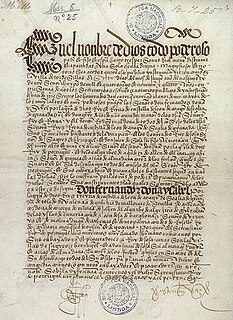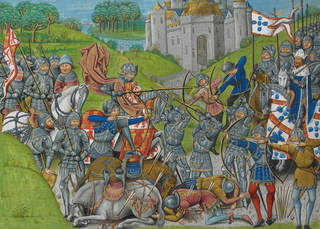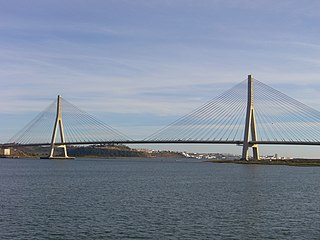
The Treaty of Tordesillas, signed in Tordesillas, Spain on 7 June 1494, and authenticated in Setúbal, Portugal, divided the newly-discovered lands outside Europe between the Portuguese Empire and the Spanish Empire, along a meridian 370 leagues west of the Cape Verde islands, off the west coast of Africa. That line of demarcation was about halfway between the Cape Verde islands and the islands entered by Christopher Columbus on his first voyage, named in the treaty as Cipangu and Antilia.

Philip the Handsome, also called the Fair, was ruler of the Burgundian Netherlands and titular Duke of Burgundy from 1482 to 1506 and the first Habsburg King of Castile for a brief time in 1506.

Ferdinand I, sometimes called the Handsome or occasionally the Inconstant, was the King of Portugal from 1367 until his death in 1383. His death led to the 1383–85 crisis, also known as the Portuguese interregnum.

Beatrice was the only surviving legitimate child of King Ferdinand I of Portugal and his wife, Leonor Teles. She became Queen consort of Castile by marriage to King John I of Castile. Following her father's death without a legitimate male heir, she claimed the Portuguese throne, but lost her claim to her uncle, who became King John I of Portugal, founder of the House of Aviz.

The Battle of Aljubarrota was fought between the Kingdom of Portugal and the Crown of Castile on 14 August 1385. Forces commanded by King John I of Portugal and his general Nuno Álvares Pereira, with the support of English allies, opposed the army of King John I of Castile with its Aragonese, Italian and French allies at São Jorge, between the towns of Leiria and Alcobaça, in central Portugal. The result was a decisive victory for the Portuguese, ruling out Castilian ambitions to the Portuguese throne, ending the 1383–85 Crisis and assuring John as King of Portugal.

The Treaty of Alcáçovas was signed on 4 September 1479 between the Catholic Monarchs of Castile and Aragon on one side and Afonso V and his son, Prince John of Portugal, on the other side. It put an end to the War of the Castilian Succession, which ended with a victory of the Castilians on land and a Portuguese victory on the sea. The four peace treaties signed at Alcáçovas reflected that outcome: Isabella was recognized as Queen of Castile while Portugal reached hegemony in the Atlantic Ocean.

The 1383–1385 Portuguese interregnum was a civil war in Portuguese history during which no crowned king of Portugal reigned. The interregnum began when King Ferdinand I died without a male heir and ended when King John I was crowned in 1385 after his victory during the Battle of Aljubarrota.
The papal bull Aeterni regis [English: "Eternal kings"] was issued on 21 June 1481 by Pope Sixtus IV. It confirmed the substance of the Treaty of Alcáçovas, reiterating that treaty's confirmation of Castile in its possession of the Canary Islands and its granting to Portugal all further territorial acquisitions made by Christian powers in Africa and eastward to the Indies.

Eleanor of Austria, also called Eleanor of Castile, was born an Archduchess of Austria and Infanta of Castile from the House of Habsburg, and subsequently became Queen consort of Portugal (1518–1521) and of France (1530–1547). She also held the Duchy of Touraine (1547–1558) in dower. She is called "Leonor" in Spanish and Portuguese and "Eléonore" or "Aliénor" in French.

Catherine of Lancaster was Queen of Castile by marriage to King Henry III of Castile. She governed Castile as regent from 1406 until 1418 during the minority of her son.

Isabella, Princess of Asturias was the eldest daughter and heir presumptive of King Ferdinand II of Aragon and Queen Isabella I of Castile. She was Queen of Portugal as the wife of King Manuel I from their marriage on 30 September 1497 until her death the next year. Her younger siblings were John, Prince of Asturias, and Queens Joanna of Castile, Maria of Portugal and Catherine of England.

Infanta Beatriz of Portugal was a Portuguese infanta, daughter of John, Constable of Portugal and Isabella of Barcelos a daughter of Afonso I, Duke of Braganza.

Ayllón is a municipality located in the province of Segovia, Castile and León, Spain. According to the 2019 census (INE), the municipality had a population of 1,196 inhabitants.
The Treaty of Badajoz was signed in Badajoz on 16 February 1267 between King Alfonso X of Castile and King Afonso III of Portugal. Both signatories agreed to establish lines of mutual assistance and friendship. Based on the terms of the accord, Alfonso X surrendered all rights to the Kingdom of the Algarve, which included the service of fifty knights. Moreover, he commanded his lieutenants to surrender the castles they controlled in Algarve to the Kingdom of Portugal. Despite all this, Alfonso X still continued to use the title king of the Algarve even though it was probably used in reference to the territory of Niebla. Both signatories agreed to use the Guadiana River from Elvas and Badajoz to Ayamonte on the Atlantic Ocean as the boundary line separating Castile and Portugal. This, in turn, forced Portugal to surrender Aracena, Moura, Serpa, and Aroche located east of the boundary line. North of the boundary line, Portugal was able to maintain Arronches, Alegrete, and Elvas, but was forced to capitulate Valencia de Alcántara and Marvão.

Portugal–Spain relations describes relations between the governments of the Portuguese Republic and the Kingdom of Spain. The two states make up the vast majority of the Iberian Peninsula and as such, the relationship between the two is sometimes known as Iberian relations.

Ferdinand II was King of Aragon from 1479 until his death in 1516. As the husband of Queen Isabella I of Castile, he was King of Castile from 1474 to 1504 as Ferdinand V. He reigned over a dynastically unified Spain jointly with Isabella; together they are known as the Catholic Monarchs. Ferdinand is considered de facto the first king of Spain, being described as such during his own lifetime, although Castile and Aragon remained de jure two different kingdoms until the Nueva Planta decrees of 1707 to 1716.

The Fernandine Wars were a series of three conflicts between the Kingdom of Portugal under King Ferdinand I and the Crown of Castile under Kings Henry II and later John I. They were fought over Ferdinand's claim to the Castilian succession after the murder of King Peter of Castile in 1369.

The kingdom of Portugal was established from the county of Portugal in the 1130s, ruled by the Portuguese House of Burgundy. During most of the 12th and 13th centuries, its history is chiefly that of the gradual reconquest of territory from the various Muslim principalities (taifas) of the period.

The Portugal–Spain border is referred to as "The Stripe". It is one of the oldest borders in the world. The current demarcation is almost identical to that defined in 1297 by the Treaty of Alcañices. The Portugal–Spain border is 1,214 km (754 mi) long, and is the longest uninterrupted border within the European Union. The border is not defined for 18 km (11 mi) between the Caia river and Ribeira de Cuncos, because of the disputed status of Olivenza/Olivença, which has been disputed between the two countries for two hundred years.

The Treaty of Alcañices was made in Alcañices between King Denis of Portugal and King Fernando IV of Castile in 1297.